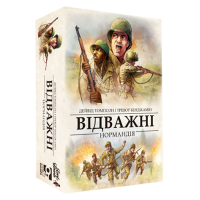Deck Building on D-Day
Related Products
Undaunted: Normandy is an interesting hybrid. Part deck-building game and part traditional wargame, it's as accessible to wargamers as it is to those who've never placed a cardboard token on a hex on the battlefield. Undaunted: Normandy tells the story of the exploits of the US 30th Infantry Division in June 1944 as they move into France to fight Nazi Germany. The development of scenarios reflects real events, adding a sense of authenticity and seriousness to the game.
To start the game, players take the side of the US 30th Infantry Division or a mixed platoon of the German Wehrmacht and choose one of 12 scenarios. The scenario booklet tells players how to build their decks, how to build stocks from which to draw new cards, how to place tiles to create a unique scenario environment, and the victory conditions for each side.

FROM D-DAY TO THE BLOODY STREETS OF MORTAIN
Scenarios vary by objective, but their progression acts as a tutorial, linearly adding more complex troops and effects as players play through them. The problem with this approach is that it hinders replayability, as players who are familiar with the mechanics are forced to play with reduced decks for most scenarios. The tragically unwarranted solution is that the final scenario works as a sort of "standard battle" with all card types in play and symmetrical starting situations for both players. It's a little weak compared to more robust card war games like Command and Colors .
A campaign that combines each scenario into a long game with many battles helps solve this problem. Wins are the primary measure of campaign success, but minimizing losses is also important, as certain thresholds forfeit campaign victory points. In practice, this resulted in several games where my wife and I had to consider abandoning our objective and losing the scenario rather than holding on to the end. Is it worth prolonging almost certain defeat to get the result of our campaign? Brave: The Normandy campaign adds nuance that is sorely lacking in a standalone, scenario-based game, and adds weight to the game's themed world. This is important when your soldiers die.
.png)
EXCITING COMBINATION OF MECHANICS. HOW INTERESTING IS THE UNDAUTED: NORMANDY
Deck building mechanics are cleverly used to subtly nudge players closer to World War II small-unit combat tactics. Each card in a player's hand represents either an individual soldier belonging to a designated unit, a commander capable of influencing the deck, or a useless fog of war card.
Soldiers can be played to activate their squad token on the game map and perform one action. All of these activities weave wonderfully into the mechanics of deckbuilding and the core element of war. Scouts can shoot, but they can also add a Fog of War card to their opponent's deck or remove it from their own deck. Machine gunners can shoot with two dice or lead suppressive fire by doubling their attack dice to knock up an enemy counter instead of damaging it. This forces the card player to flip that unit back before it can act normally. These examples highlight how skillfully David Thompson weaves the military theme into the mechanics of Undaunted: Normandy .
.png)
TRY YOUR LUCK WITH THE INITIATIVE
On a given turn, players draw four cards before laying one down to determine initiative. This card will be discarded after the initiative phase, thus players will lose the ability to use it on the field. Each card has an initiative value that corresponds to its overall utility and importance. This is a crucial move, as the initiative player will play his entire hand before his opponent. Refusing the commander to go first can cripple the player's turn, but he has to evaluate whether it's worth it to make sure he can move his squad to cover before being ripped apart by an enemy machine gun.
After initiative, players play all their cards in turn, taking one action for each. There are some minimal deck-building synergies that players can employ, such as stacking cards of a particular troop into their deck and then trying to use commanders to draw additional ones. However, in most cases, deck construction works to enhance the combat gaming aspect of Undaunted: Normandy , simulating the degradation of command and control, the relative effectiveness of depleted squads, and abstracting away officer intuition.

A VISUAL ASPECT THAT PAYS OFF
Visually, the game is fantastic. The tiles that make up the battlefield are solid, their coverage values are clearly marked, and the terrain they model is nice and crisp. The cards on both sides consist of cartoon-style names of individuals, and I admit it took me a while to appreciate. Playing the game now, I can't imagine it looking any other way. The fact that individual soldiers are named helps players relate their actions. When a unit is hit and the player is forced to permanently discard a card from that squad, they say goodbye to that person for the rest of the game. It's a subtle but impressive part of the thematic aspect.
The deck building mechanics are a revelation, even after all this time. My wife and I enjoyed Undaunted: Normandy as much as we did a year ago when we first played it. The campaign is definitely the way to play the game, and because of the nuances it adds, we may even be playing it again months later. Undaunted: Normandy is definitely worth a try for fans of war games, fans of deck building.
USEFUL LINKS
Undaunted: Normandy on the BGG portal
https://boardgamegeek.com/boardgame/268864/undaunted-normandy
Undaunted: Normandy on the Game Theory portal
https://www.tg.in.ua/boardgames/414/undaunted-normandy
VIDEO REVIEWS




